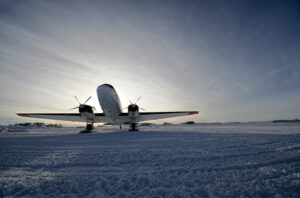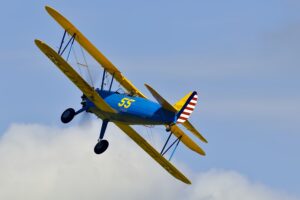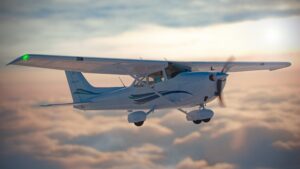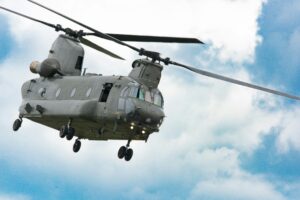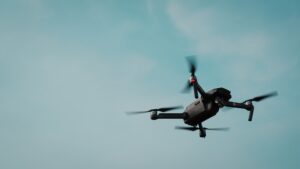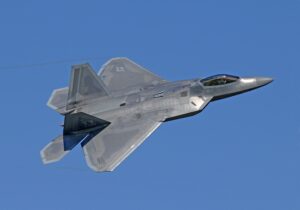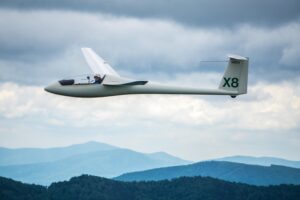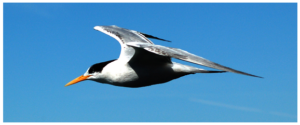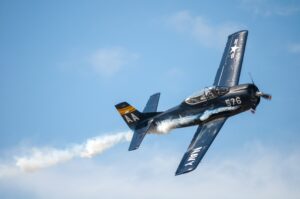Myth: The horizontal air over the wing produces lift.
Reality: The air producing lift is accelerated perpendicular to the direction of motion of the wing, not across it.
We are taught to have a mindset that the wing is stationary and the air is flowing over it. This mindset arises from wing airflow graphics and wind tunnel videos. Add to this the belief that faster air means lower pressure (Misconception of Flight #1) and that lift depends on the shape of the wing (Misconception of Flight #2), and we have all the stumbling blocks needed to misunderstand lift.
“The air is still; It is the airplane that moves.”
– From page 22 of Stick & Rudder, An Explanation of the Art of Flying by Wolfgang Langewiesche, 1944
Still Air
We start with one essential fact to understand a wing’s lift. Neglecting turbulence, aircraft fly in still air. Like a hot-air balloon, when an aircraft leaves the ground, it becomes part of the air mass. That is why air speed and ground speed often have little relationship. Above the clouds, without reference to the instruments, one cannot tell the difference between a 100-mph headwind, tailwind, or crosswind. Not understanding this has led some to believe that if one turns downwind for a landing, one might stall. It’s a rare day when an aircraft’s ground speed and track agree with the air speed and heading.
Swing your flattened hand through the air. It is your hand moving through the air, not the air flowing over your hand. It is the same with a wing in flight. It is the wing moving through the air, not the air flowing over the wing. This epiphany led us to understand the enigma of flight.
Air Over a Wing that Produces Lift
We start with a brief consideration of Newton’s third law of motion, which states: If object A exerts a force on object B, then object B must exert a force of equal magnitude and opposite direction back on object A. This law represents a symmetry in nature: forces always occur in pairs on paired objects.
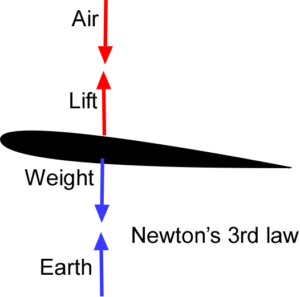
Now let’s look at the forces on a wing in Figure 1. We are all familiar with the forces of weight and lift on a wing, but these are not paired forces, and there is only an “object A”, the wing. The weight is a force on the airplane caused by the pull of gravity. The paired force is the force the airplane puts on the Earth. They pull on each other just like the Earth and the moon pull on each other.
The lift on the wing is up, therefore, it must put a downward force on the air. To understand why the air is accelerated down, refer to Figure 2.
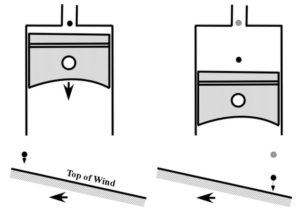
The air above the wing is exposed to a descending surface like a piston pulled down in a vacuum pump. This lowers the pressure above the wing, and the air accelerates toward the lowered pressure. (Nature abhors a vacuum and all that.) This has put energy into the descending air. After the wing passes, the air continues down (this is known as downwash). The air being drawn down by a descending piston is the same as what happens when you inhale. Your lungs expand, lowering the pressure in your lungs, and the ambient outside pressure pushes air into your lungs to restore atmospheric pressure.

This is contrary to what most of us have been taught, that the air comes smoothly off the wing’s trailing edge (Figure 3). To help you internalize this new concept, consider the rotors on a helicopter hovering over the water, a propeller, and a ceiling fan as shown in Figure 4. All are legitimate wings. One thing they all have in common is that they accelerate air perpendicular to the plane of motion. The Wright brothers developed the modern propeller by realizing that a propeller was a rotating wing. Watch the helicopter video at the end of this web page to see how air is accelerated perpendicular to the blade’s plane (no pun intended) of motion.
As an aside regarding Newton’s Third Law of Motion, if an airplane flies over a scale, you could weigh it. The Earth doesn’t become lighter when an aircraft takes off. This also answers the old question: If an airplane were full of canaries in cages and the canaries were made to fly, would it lower the load on the airplane’s wings? The answer is “NO”. The load on the floor did not change.

Acceleration of air over various wings.
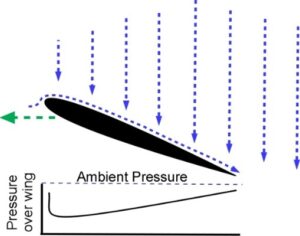
The air comes vertically off the wing as shown in Figure 5. The air that produces the lift flows vertically.
A small amount of air flows horizontally over the wing. The lowered pressure draws the air in. However, this “flowing air” does not contribute to lift. It contributes to the upwash phenomenon. It also causes a wing to stall, as discussed in Lift Details. Upwash is considered by many to cause a lifting force on the wing. In fact, upwash is an additional load on the wing. By Newton’s third law, because the air is drawn upward, there must be a downward force on the wing.
The reduced pressure over the wing is caused by the slope of the wing accelerating the air down, not by the air flowing over the wing. This is discussed in Lift on a Wing. As we will see later, a great deal of air is accelerated down to produce the lift. A Cessna 172 at cruise accelerates on the order of 4 to 5 tons of air per second. A commercial passenger jet accelerates on the order of its weight per second.
This may seem like a lot of air to accelerate down. Maybe an example will help one get a feeling for what is happening. Take an airplane flying at 120 knots (222 km/h) with an effective angle of attack of 4 degrees. The initially still air is suddenly exposed to a descending surface of about 14 ft/s (4.26m/s). A Cessna 172 has a wing area of 174 ft2 (16 m2). That is a lot of suction. Keep in mind that a cubic yard of air (a cube 3′ on a side) at sea level weighs approximately 2 lbs. For the metric folks, a cubic meter weighs 1 kilogram (2.2 lbs).
Frame of Reference
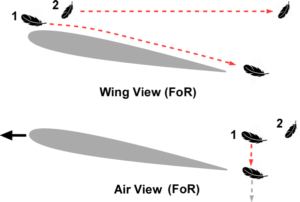
Before we discuss the frame of reference (FoR) regarding a wing, let’s take a quick refresher on the frame of reference concept using a real-life situation most people have observed. It’s raining and/or snowing. You’re in a vehicle at a stop sign. Looking out the vehicle’s side window, you note that the rain or snow is falling vertically. As the vehicle accelerates, you look out the side window and note that the rain or snow is falling at an angle. The faster the vehicle goes, the more horizontal the falling rain or snow appears to be. As the vehicle slows, the angle moves back toward vertical until at a stop, when the falling rain or snow is vertical. From the vehicle frame of reference (FoR), the angle of the falling rain or snow varies with speed. The rain or snow is falling vertically from the observer’s perspective, standing next to the road FoR. The vehicle’s FoR corresponds to the Wing FoR, whereas the Observer FoR corresponds to the Air FoR. For a few more frame of reference examples, see the section below the frames of reference for a wing.
A Wing’s Frames of Reference
Now on to the frames of reference regarding a wing in flight and in a wind tunnel. Imagine standing on a high hill and watching an airplane fly by. On this day, there is no wind, and the air is still. Referring to Figure 6, as the airplane gets close, it flies under feather #1, lost by a high-flying goose. Feather #2 is at the same altitude as feather #1 but far enough away not to be affected by the wing’s passage. You and the pilot watch the wing pass under Feather #1 and past Feather #2. What you and the pilot see are very different. The pilot sees one feather pass over the wing and come off the trailing edge at a slight downward angle. This is viewed in the Wing frame of reference (FoR). The Wing FoR agrees nicely with what the pilot has been taught and what one observes in a wind tunnel. The air flows across the wing and comes smoothly off the trailing edge, as in Figure 1. The pilot sees Feather #2, which we know is stationary, go straight back at the same speed as Feather #1, though the second feather remains at the same altitude.
On the other hand, you are on the ground and occupy the Air FoR in Figure 6. You see that Feather #1 goes straight down, which agrees with what we know about the true direction of a wing’s downwash. Feather #2 remains stationary. Feather #1’s motion demonstrates that the air is accelerated perpendicular to the flight path.
What one observes in a wind tunnel is the Wing FoR, i.e., the wing is stationary, and the air is moving. The observed wind tunnel airflow around a wing distorts one’s perception and understanding of how a wing develops lift. In flight, the air is stationary, and the wing is moving. In a wind tunnel, a camera moving with the air would see the air being accelerated perpendicular to the “flight path,” producing an upward force.
A few more frame of reference examples.
When you look out the window of a high-flying passenger jet, you can believe that the airplane is stationary and the Earth is moving below. Someone on the ground sees the earth as stationary and the airplane moving. Thus, we have two frames of reference: the airplane frame of reference and the Earth frame of reference.
Have you been on a stationary bus or train that is next to another stationary bus or train? Then you notice the other bus or train begins to move? Or is the bus or train you’re on beginning to move? You cannot determine this without observing a separate and fixed, i.e., non-moving, reference point. This fixed point is known as the rest reference frame. From the rest reference frame, the relative motions can be determined.
You’re in a vehicle looking out a side window. You observe buildings, trees, fences, people, etc., going in the opposite direction. Now, common sense strongly suggests it’s unlikely buildings and trees are traveling at any speed. We make the intuitive “leap” that the vehicle is moving. But is this true? You might be on a movie set where the scenery is scrolling past a stationary vehicle! All are frames of reference. From the reference frame of the vehicle, it appears the buildings, etc., are moving. From the reference frame of the buildings and trees, it appears the vehicle is moving. It’s only by knowing the rest reference frame can an accurate portrayal of the situation can be made.
Have you ever been sitting stopped in traffic and not paying attention when the car beside you starts to move? For a moment, you may not be sure if the car next to you is moving forward or you’re slipping back. If so, for that split second, you are confused about your frame of reference. It’s by finding a known frame of reference that you can correctly perceive what is occurring. In the car, you may look at the ground or buildings and know the ground and buildings aren’t moving (most likely unless you’re in an active earthquake zone).
Takeaways:
1. A wing accelerates air perpendicular to its direction of motion.
2. The small amount of air flowing over the wing does not produce lift.
A dramatic example of air being accelerated perpendicular to the plane of rotation in the following video.
